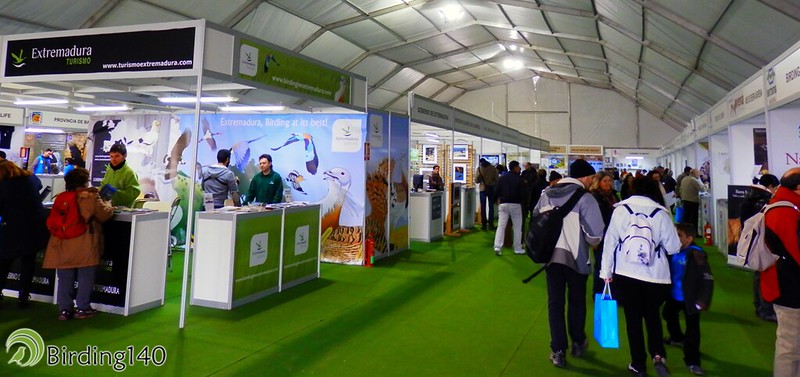FIO 2014 took place, as every year, at the emblematic Monfragüe National Park. With a party mood and a damp smell, birdwatchers from south Europe gathered at their annual meeting in the small village of Villarreal de San Carlos.
There were three days to enjoy the latest in photography equipment in a space dedicated to optics and cameras, with noteworthy exhibitors like Óptica Roma and Martín Iglesias. In this area we also found Oryx, with a wide publications catalogue for sale. We couldn’t obviously resist and we increased the weight of our backpacks.
The space dedicated to art and nature was a novelty at FIO 2014 where painters, sculptors and photographers showed their work. In this area of the fair, the finalist pictures of the Fotofio 2014 competition were also exhibited; among them was the spectacular “Amago de reyerta” (fight feint), by José Luis Valiña.
Interesting talks and workshops were held at the tent dedicated to Fotofio 2014. Of those we could attend, our favourite was Yossi Eshbol and Itai Shanni’s talk on how the increasing population of cranes at the valley of Hula due to supplementary feeding attracted several predatory species and the “beloved” tourists.
At the space dedicated to travels and tourism, many Spanish and Portuguese regions and municipalities promoted their tourist attractions. Although we missed a greater presence of companies with their own stand in this area, very few took the step. We found the three FIO newcomers interesting: the magazine Quercus, making known its new stage with the ownership in the hands of the editorial team; Aragon, with the Pyrenees as a symbol, and Andalusia, with its emblematic Doñana National Park. As in every edition, the ornithological tourist offering from Extremadura was huge. Little by little, the spreading of destinations in the province of Badajoz is also increasing. Extremadura is not just Monfragüe, but also Sierra de San Pedro, Guadiana International Bridge and many other exceptional settlements for bird watching.
At FIO 2014 there was also place for children. At the tent dedicated to children activities they were able to draw, build food dispensers, read and comment fables, dress up and play during the three days of the FIO 2014. There was also a bird ringing workshop for children and adults organised by SEO Cáceres, and guided routes through Monfragüe.
The conference programme at FIO 2014 was very interesting and with varied topics, from the “evolutionary history of the Azure-winged Magpie” to the “Interactive National Parks”. Although we couldn’t attend all the talks, we want to point out two initiatives we found specially interesting. On the one hand, the introduction of the VIII European Crane Conference, which will be held next November by the Asociación de Amigos de Gallocanta (Friends of Gallocanta Association); on the other hand, the “Monfragüe Birdcenter” project, a nature interpretation centre that will open next spring, and which the Torrejón el Rubio city council wants to turn into a centre for the study of the birds of Monfragüe.
The most touching talk of FIO 2014 was certainly the one held by the current owners of Quercus magazine. They told us how the founders, Benigno Varillas and Teresa Vicetto, put the nowadays legendary “number zero” on kiosks all around Spain. It was a modest diptych which summed up the articles the magazine would include if they reached the necessary amount of subscribers to edit it. Miraculously, 700 nature-crazy people —some of them were present at the talk— accepted the challenge and that’s how Quercus was born.
At the beginning of the 90’s, the magazine got professional status and began accepting advertising, starting to be part of the publishing house América Ibérica. However, in 2013, due to the restructuring of the publishing group and the lack of offers from other publishing houses to buy the masthead, the decision was taken to close down Quercus. Despite having quite a numerous subscriber base, the most important nature magazine in Spain was about to disappear.
There was only one possibility left to avoid it: the editorial team took charge of Quercus, establishing their own publishing company and betting on the spirit of those 700 nature-crazy people who subscribed to a non-existent magazine. We wish you the best of luck and let’s hope Quercus never disappears.
Lastly, as attendants to FIO 2014, we want to thank all the people who have worked there during these three days for their dedication: to the people in charge of children activities, who treated the children with real affection; to the people in charge of the information points, and also to the person on the exit of the tent at the tourism and travels area, who patiently indicated each and every of the 10 000 attendants not to forget visiting the small tent, that wasn’t less important in spite of its size. We also want to emphasize the cleanliness of the place; despite brochures being handed out inside the tents, there wasn’t a single paper on the floor outside them.
To sum up: FIO 2014 has been a great fair.
If you have enjoyed this post please share it on your social networks.














